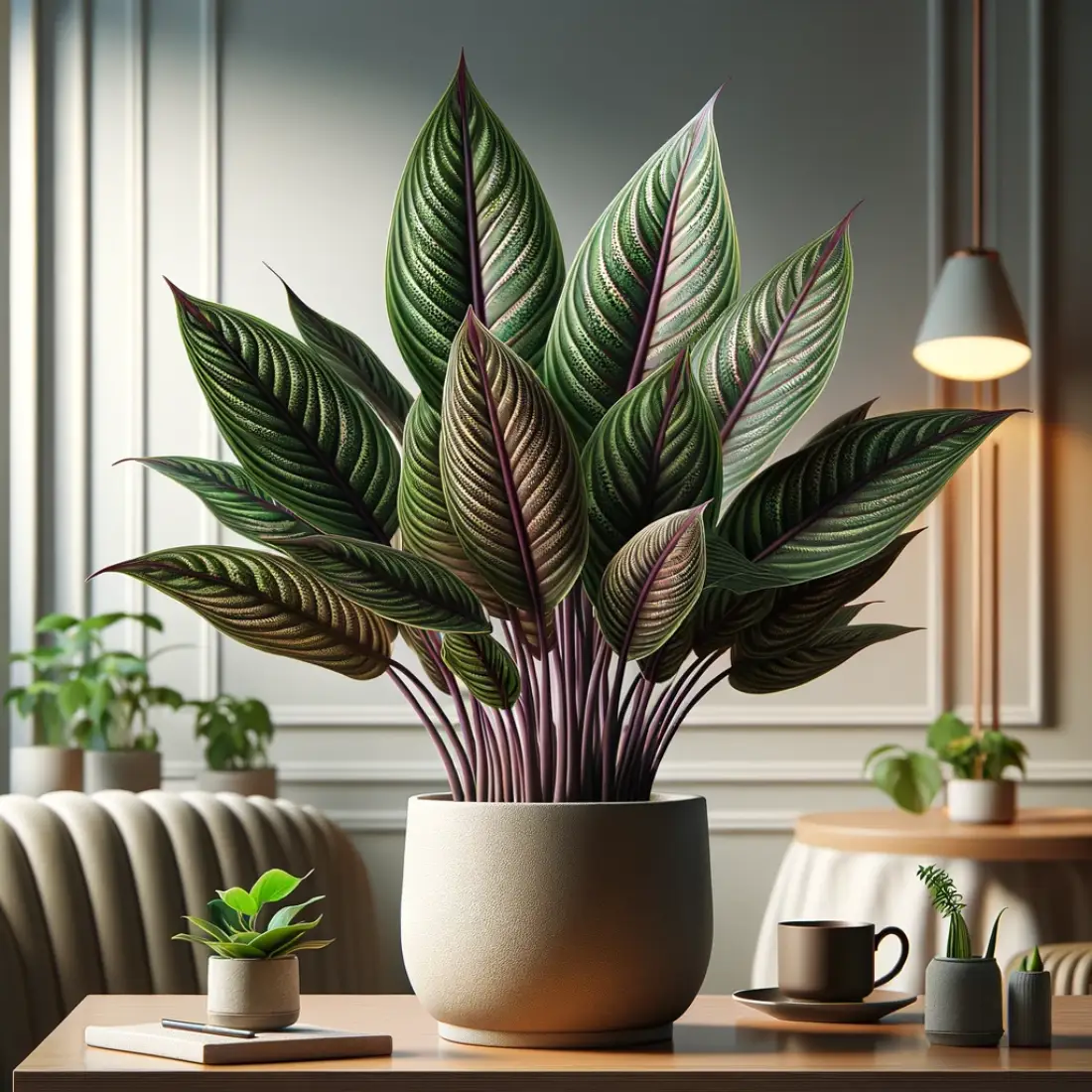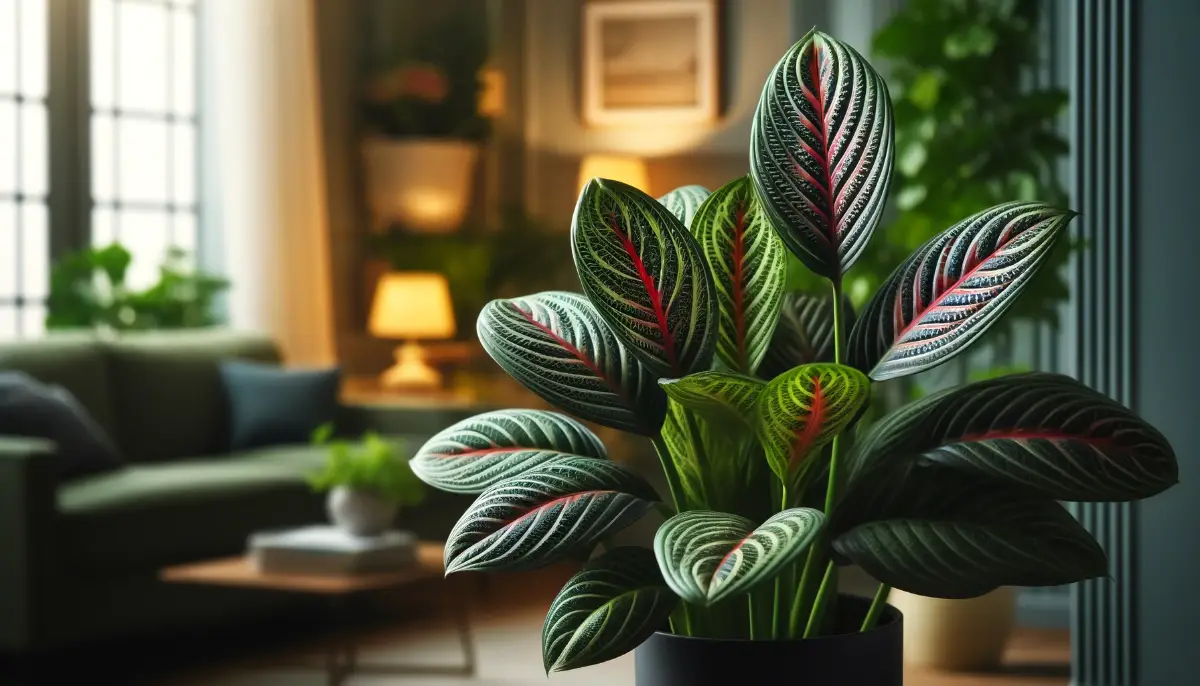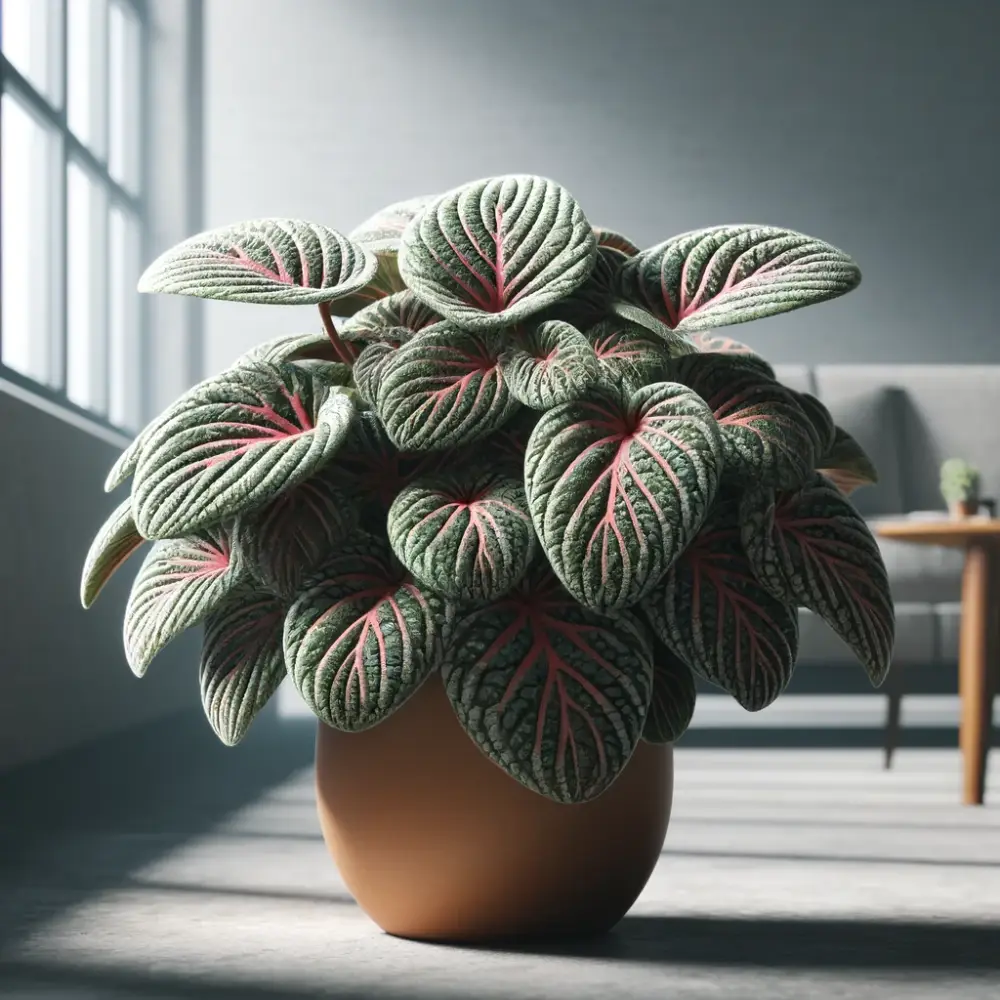The Calathea Makoyana, commonly known as the Peacock Plant, is a striking houseplant that captivates with its unique and vibrant foliage. Named for its intricate leaf patterns that resemble the plumage of a peacock, this plant is a favorite among indoor plant enthusiasts for its decorative appeal and relatively easy care requirements.
What sets the Calathea makoyana apart is its stunning leaves. Each leaf is characterized by a dark green pattern on a light green background, with the underside of the leaf displaying a rich purple hue.
The leaves are thin and delicate, often moving in response to light and temperature changes, a phenomenon known as nyctinasty. This rhythmic movement adds a dynamic and almost lively presence to any indoor space.
[zynith-toc]
Choosing the Right Environment
Indirect, Filtered Light
- The Calathea makoyana thrives in bright, indirect light. It should be placed in a location where it can receive plenty of filtered light, such as near a north or east-facing window.
- Direct sunlight can scorch the delicate leaves, causing them to fade or develop brown patches. If the plant is exposed to direct sunlight, consider using sheer curtains to diffuse the light.
Avoid Direct Sunlight
- While some houseplants can tolerate direct sunlight, the Peacock Plant is not one of them. Prolonged exposure to direct sun can lead to leaf burn and stress.
- If your home lacks sufficient natural light, consider using grow lights to provide the necessary illumination without the risk of scorching the leaves.
Ideal Temperature Range
- Calathea makoyana prefers a warm environment. It thrives best in temperatures between 65°F and 75°F (18°C to 24°C). It is important to maintain consistent temperatures, avoiding sudden fluctuations.
- Avoid placing the plant near drafty windows, doors, or heating and cooling vents where temperatures can vary drastically.
Humidity
- High humidity is essential for the Peacock Plant’s health. Aim to maintain humidity levels around 60-70%, which mimics its native tropical environment.
- Increase humidity by placing the plant on a humidity tray, using a room humidifier, or grouping it with other humidity-loving plants. Regular misting can also help, but be cautious not to overdo it, as excess moisture can lead to fungal issues.
Creating the right environment for your Calathea makoyana is crucial to its well-being. By providing the appropriate light, temperature, and humidity conditions, you can ensure that your Peacock Plant remains healthy and vibrant, showcasing its stunning foliage to its fullest potential.
Planting and Potting
Soil Requirements
- Calathea makoyana thrives in a well-draining potting mix to prevent waterlogging, which can lead to root rot. A mix designed for houseplants, particularly those suited for tropical plants, works well.
- A suitable potting mix can be made by combining equal parts of peat moss, perlite, and potting soil. This blend ensures good aeration and retains adequate moisture without becoming soggy.
- The ideal soil pH for the Peacock Plant ranges from slightly acidic to neutral (6.0-7.0). Most commercial potting mixes fall within this range, but it’s beneficial to check the pH if you’re creating your own mix.
Choosing the Right Pot
- Select a pot that has drainage holes at the bottom to allow excess water to escape. Proper drainage is essential to prevent the roots from sitting in water, which can cause root rot.
- Avoid pots without drainage holes unless you are using them as decorative outer pots. In such cases, ensure the plant is in a well-draining inner pot that can be removed for watering.
- Choose a pot that is slightly larger than the current root ball of the plant. A pot that is too large can hold excess moisture, leading to overwatering issues.
- When repotting, increase the pot size by about 1-2 inches in diameter. This allows room for the roots to grow without overwhelming the plant with too much soil.
Planting Procedure
Preparation
- Before planting, ensure all materials (pot, soil mix, tools) are clean to reduce the risk of introducing pests or diseases.
- Pre-moisten the potting mix slightly to make it easier to handle and to provide a welcoming environment for the plant’s roots.
Planting Steps
- Place a layer of potting mix at the bottom of the pot.
- Gently remove the Calathea makoyana from its current pot, being careful not to damage the roots. If the plant is root-bound, gently loosen the roots to encourage new growth.
- Position the plant in the center of the new pot, ensuring it sits at the same depth as it was in the previous pot.
- Fill in around the roots with the potting mix, pressing lightly to eliminate air pockets. Avoid compacting the soil too much, as this can hinder root growth.
- Water the plant thoroughly until water drains out of the bottom holes, ensuring the soil is evenly moist.
Watering Schedule
Consistent Moisture, But Not Waterlogged
- Calathea makoyana requires consistent moisture to thrive. The soil should be kept evenly moist but not waterlogged. Overwatering can lead to root rot, while underwatering can cause the leaves to curl and dry out.
- Check the soil moisture regularly, especially during the growing season (spring and summer). The top inch of the soil should feel slightly dry before you water again.
Watering Frequency
- Generally, the Peacock Plant should be watered when the top inch of soil feels dry to the touch. This usually means watering about once a week, but the frequency can vary depending on environmental factors such as humidity, temperature, and light conditions.
- During the winter months, reduce the watering frequency slightly, as the plant’s growth slows down and it requires less water.
Use Distilled or Rainwater
- Calathea makoyana is sensitive to the chemicals and minerals found in tap water, such as chlorine, fluoride, and salts. These substances can cause leaf tip burn and discoloration.
- Use distilled water, rainwater, or filtered water for the best results. Allowing tap water to sit out overnight can also help dissipate some of the chlorine, but it may not remove all harmful minerals.
Avoid Tap Water with High Mineral Content
- If you must use tap water, check its mineral content. High levels of calcium and magnesium can build up in the soil and harm the plant.
- Regularly flushing the soil with distilled or rainwater can help remove any accumulated salts and minerals.
Additional Tips for Watering
- Water the soil directly, avoiding the leaves. Wet leaves can be prone to fungal infections and spotting.
- Ensure even watering by slowly pouring water around the base of the plant until it begins to drain out of the bottom. This ensures that the entire root system gets adequate moisture.
Monitoring Humidity
- High humidity is crucial for Calathea makoyana. In addition to regular watering, increase humidity by misting the plant, using a humidifier, or placing the pot on a tray filled with pebbles and water.
- Avoid placing the plant near drafts, heating vents, or air conditioners, as these can dry out the air and reduce humidity.
By following these watering guidelines, you can help ensure that your Calathea makoyana remains healthy and vibrant. Consistent, proper watering is key to maintaining the lush foliage that makes this plant so attractive.
Feeding Frequency
During the growing season (spring and summer), feed your Calathea makoyana every 4-6 weeks with an organic fertilizer. Reduce feeding frequency in the fall and winter months when the plant’s growth slows down. Feeding once every 8-10 weeks during this period is sufficient.
Application Method
Compost Tea: Brew compost tea according to the instructions, typically by soaking compost in water for 24-48 hours. Water the plant with the compost tea, ensuring the soil is evenly moist.
Worm Castings: Mix worm castings into the top layer of the soil, or make a worm casting tea by soaking castings in water and using the liquid to water the plant.
Fish Emulsion: Dilute fish emulsion according to the package instructions. Apply it to the soil around the base of the plant, avoiding direct contact with the leaves.
Seaweed Extract: Dilute the seaweed extract as directed. Use it as a foliar spray or water the soil with it, depending on the product instructions.
Monitoring Plant Health
- Observe your Calathea makoyana for signs of nutrient deficiency, such as pale or yellowing leaves, slow growth, or poor overall appearance. Adjust feeding frequency and fertilizer type if necessary.
- Organic fertilizers release nutrients slowly, reducing the risk of over-fertilization and providing a steady supply of nutrients to the plant.
Additional Tips for Organic Feeding
- Incorporate organic matter into the soil during repotting to improve soil fertility and structure.
- Avoid over-fertilizing, as excess nutrients can lead to leaf burn and other health issues. Organic fertilizers are generally safer in this regard, but it’s still important to follow recommended application rates.
- Combine different types of organic fertilizers to provide a balanced nutrient profile. For example, use compost tea for regular feeding and supplement with fish emulsion or seaweed extract for a nutrient boost.
Maintenance and Care
Pruning
Pruning is essential for maintaining the health and appearance of Calathea makoyana. It helps remove damaged or diseased leaves, encourages new growth, and keeps the plant looking tidy. Use clean, sharp scissors or pruning shears to make clean cuts and reduce the risk of infection.
Disinfect the tools before and after use with rubbing alcohol or a bleach solution to prevent the spread of disease.
When to Prune
Prune as needed throughout the year to remove yellowing, dead, or damaged leaves. Perform more extensive pruning during the plant’s active growing season (spring and summer) to encourage new growth and shape the plant.
Pruning Steps
- Inspect the Plant: Regularly check the plant for any yellowing, browning, or damaged leaves. Look for signs of pests or diseases.
- Remove Damaged Leaves: Using clean, sharp scissors or pruning shears, cut off any yellow or brown leaves at the base of the stem. This helps the plant redirect energy to healthy growth.
- Trim Spent Flowers: If your Calathea makoyana produces flowers, remove spent blooms to encourage more flowering and prevent energy wastage.
- Shape the Plant: If the plant becomes leggy or overgrown, trim back some of the stems to encourage bushier growth. Cut just above a leaf node (where a leaf joins the stem) to promote new growth.
Dispose of pruned leaves and stems properly. Do not leave them around the plant, as they can attract pests and diseases. If the pruned material shows signs of disease or pests, dispose of it in the trash rather than composting to prevent spreading the problem.
After pruning, monitor the plant closely for any signs of stress or shock. Ensure it is placed in an optimal environment with the right light, humidity, and watering conditions.
Resume regular care routines, including watering and feeding, to support the plant’s recovery and promote healthy new growth.
Benefits of Regular Pruning
- Healthier Plant: Removing diseased or damaged leaves prevents the spread of infections and pests.
- Aesthetic Appeal: Regular pruning keeps the plant looking tidy and attractive, enhancing its decorative value.
- Encourages Growth: Pruning stimulates new growth and can help the plant become fuller and bushier.
- Prevents Overcrowding: By managing the size and shape of the plant, you can prevent overcrowding and ensure adequate air circulation, reducing the risk of fungal diseases.
Propagation
Division Method
The ideal time to propagate Calathea makoyana is during the spring, when the plant is actively growing. This minimizes stress on the plant and promotes quicker recovery and establishment of new plants.
Preparation for Propagation
Gather necessary materials: a sharp knife or shears, clean pots with drainage holes, and a well-draining potting mix (the same mix used for mature plants is suitable).
Water the plant thoroughly the day before propagation to ensure it is well-hydrated, making it easier to separate the roots.
Steps for Division Propagation
- Remove the Plant from Its Pot: Gently remove the Calathea makoyana from its pot, taking care not to damage the roots. You may need to loosen the soil around the edges to free the root ball.
- Inspect the Root Ball: Examine the root ball for natural divisions. Healthy divisions will have a good amount of roots and at least a few leaves attached.
- Separate the Plant: Using a sharp knife or shears, carefully divide the plant into smaller sections. Each section should have a healthy root system and several leaves. If the roots are tangled, gently tease them apart with your fingers.
- Pot the Divisions: Place each division into a new pot filled with a well-draining potting mix. Position the plant so that it sits at the same depth as it was in the original pot. Fill in around the roots with soil, pressing lightly to eliminate air pockets.
- Water Thoroughly: Water the newly potted divisions thoroughly to settle the soil and ensure good root-to-soil contact. Allow excess water to drain out.
Pest and Disease Management
Common Pests
Spider Mites
- Identification: Tiny, spider-like pests that create fine webs on the undersides of leaves. They cause yellowing, stippling, and leaf drop.
- Treatment: Increase humidity around the plant, as spider mites thrive in dry conditions. Use insecticidal soap or neem oil to treat infestations. Apply thoroughly, ensuring coverage on the undersides of leaves.
Mealybugs
- Identification: White, cotton-like clusters usually found on leaf joints and undersides. They suck plant sap, leading to weakened growth and yellowing leaves.
- Treatment: Remove mealybugs with a cotton swab dipped in rubbing alcohol. For larger infestations, use insecticidal soap or neem oil. Repeat treatments weekly until the pests are eradicated.
Aphids
- Identification: Small, soft-bodied insects that can be green, black, or white. They cluster on new growth and excrete sticky honeydew.
- Treatment: Wash off aphids with a strong stream of water. Use insecticidal soap or neem oil for persistent infestations. Ladybugs and other beneficial insects can also help control aphid populations.
Disease Prevention
Root Rot
- Causes: Overwatering and poor drainage leading to waterlogged soil.
- Prevention: Use a well-draining potting mix and pots with drainage holes. Water only when the top inch of soil is dry. Ensure excess water can drain away completely.
- Treatment: If root rot is detected, remove the plant from its pot, trim away affected roots, and repot in fresh, well-draining soil. Reduce watering and monitor for recovery.
Leaf Spot
- Causes: Fungal or bacterial infections, often due to high humidity and poor air circulation.
- Prevention: Water the soil directly, avoiding wetting the leaves. Ensure good air circulation around the plant. Remove any infected leaves immediately to prevent spread.
- Treatment: Use a fungicide for fungal infections and ensure proper plant hygiene. For bacterial infections, remove affected leaves and improve environmental conditions.
Powdery Mildew
- Causes: High humidity and poor air circulation can lead to this fungal disease, characterized by white, powdery growth on leaves.
- Prevention: Maintain good air circulation and avoid overcrowding plants. Ensure moderate humidity levels and avoid overhead watering.
- Treatment: Remove and dispose of affected leaves. Apply a fungicide specifically for powdery mildew, and adjust environmental conditions to reduce humidity.
Troubleshooting Common Issues
Leaf Curling
Causes
- Underwatering: One of the most common causes of leaf curling is lack of water. When the soil is too dry, the leaves will curl to conserve moisture.
- Low Humidity: Calathea makoyana thrives in high humidity. If the air is too dry, the leaves may curl to reduce water loss.
- Temperature Stress: Exposure to cold drafts or sudden temperature changes can cause leaves to curl.
Solutions
- Adjust Watering: Ensure the soil remains consistently moist but not waterlogged. Water the plant when the top inch of soil feels dry to the touch.
- Increase Humidity: Raise humidity levels by misting the plant regularly, using a humidifier, or placing the pot on a tray filled with pebbles and water.
- Stabilize Temperature: Keep the plant in a stable environment with temperatures between 65-75°F (18-24°C). Avoid placing it near drafts, air conditioners, or heaters.
Brown Leaf Edges
Causes
- Low Humidity: Brown leaf edges often indicate that the plant is not receiving enough humidity.
- Fluoride in Water: Tap water with high levels of fluoride can cause the tips of the leaves to turn brown.
- Overfertilization: Excess fertilizer can lead to salt build-up in the soil, causing leaf burn.
Solutions
- Increase Humidity: Enhance the humidity around the plant using methods mentioned above.
- Use Distilled Water: Water the plant with distilled, filtered, or rainwater to avoid fluoride damage. Allow tap water to sit out overnight to evaporate chlorine and some other chemicals.
- Flush the Soil: If overfertilization is suspected, flush the soil with distilled water to remove excess salts. Cut back on fertilizer use and follow a regular feeding schedule with organic fertilizers.
Fading Leaf Colors
Causes
- Excessive Sunlight: Direct sunlight can bleach the vibrant colors of the leaves, causing them to fade.
- Nutrient Deficiency: A lack of essential nutrients can lead to pale or yellowing leaves.
Solutions
- Adjust Light Exposure: Move the plant to a location with bright, indirect light. Avoid direct sunlight by using sheer curtains or placing the plant in a shaded area.
- Fertilize Appropriately: Feed the plant with a balanced, organic fertilizer during the growing season. Ensure the soil is nutrient-rich and consider adding compost or worm castings to improve soil health.
Yellowing Leaves
Causes
- Overwatering: Consistently waterlogged soil can lead to root rot, causing leaves to turn yellow.
- Poor Drainage: Insufficient drainage can result in water accumulation at the roots.
Solutions
- Improve Watering Practices: Allow the top inch of soil to dry out between waterings. Ensure excess water can drain freely from the pot.
- Check for Root Rot: If root rot is suspected, remove the plant from its pot, trim away affected roots, and repot in fresh, well-draining soil.
E. Leaf Spotting
Causes
- Fungal or Bacterial Infection: Spots on leaves can be caused by fungal or bacterial pathogens, often due to high humidity and poor air circulation.
- Watering Methods: Watering the leaves instead of the soil can promote the growth of pathogens.
Solutions
- Remove Affected Leaves: Trim away any leaves showing signs of spotting to prevent the spread of infection.
- Improve Air Circulation: Ensure good airflow around the plant by spacing it adequately from other plants and using a fan if necessary.
- Water Correctly: Water the soil directly and avoid wetting the leaves. Use a fungicide if fungal infection is suspected.
FAQs for Calathea makoyana (Peacock Plant) Care
How often should I water my Calathea makoyana?
Water your Calathea makoyana when the top inch of soil feels dry to the touch. Generally, this means watering about once a week, but it may vary depending on the humidity and temperature in your home.
What type of light is best for Calathea makoyana?
Calathea makoyana thrives in bright, indirect light. Avoid direct sunlight as it can scorch the leaves. A north or east-facing window with filtered light is ideal.
Why are the edges of my Calathea makoyana’s leaves turning brown?
Brown leaf edges can be caused by low humidity, fluoride in tap water, or overfertilization. Increase humidity, use distilled or rainwater, and ensure you are not over-fertilizing the plant.
How can I increase humidity around my Calathea makoyana?
Increase humidity by misting the plant regularly, using a humidifier, or placing the pot on a tray filled with pebbles and water. Grouping plants together can also help raise humidity levels.
What should I do if my Calathea makoyana’s leaves are curling?
Leaf curling can be a sign of underwatering, low humidity, or temperature stress. Ensure the soil is consistently moist, increase humidity, and keep the plant in a stable environment with temperatures between 65-75°F (18-24°C).
How do I propagate my Calathea makoyana?
The best way to propagate Calathea makoyana is through division. Carefully divide the plant during repotting in spring, ensuring each section has a healthy root system and several leaves. Plant the divisions in a well-draining potting mix and maintain high humidity.
What pests are common on Calathea makoyana, and how do I treat them?
Common pests include spider mites, mealybugs, and aphids. Treat infestations with insecticidal soap or neem oil, and maintain high humidity to deter spider mites. Regularly inspect the plant for early signs of pests.
Why are my Calathea makoyana’s leaves fading in color?
Fading leaf colors can be caused by excessive sunlight or nutrient deficiencies. Move the plant to a location with indirect light and feed it with a balanced, organic fertilizer during the growing season.
How often should I repot my Calathea makoyana?
Repot your Calathea makoyana every 2-3 years or when it becomes root-bound. The best time to repot is in the spring during the plant’s active growing season.
Can I use tap water for my Calathea makoyana?
Tap water can contain chemicals like chlorine and fluoride that may harm your plant. It’s best to use distilled, filtered, or rainwater. If you must use tap water, let it sit out overnight to allow some of the chemicals to evaporate.










